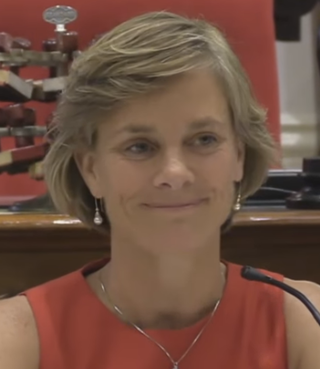Related Research Articles

South Kesteven is a local government district in Lincolnshire, England, forming part of the traditional Kesteven division of the county. Its council is based in Grantham, and the district also covers Bourne, Market Deeping and Stamford. At the 2011 Census, the population of the district was 133,788, at 1.4 per hectare in 57,344 households.

Melton is a local government district with borough status in north-eastern Leicestershire, England. It is named after its only town, Melton Mowbray. The borough also includes numerous villages and surrounding rural areas. The north of the district includes part of the Vale of Belvoir. Melton is the least populous district of its type and the fourth least populous district in England overall.

Rutland and Melton is a county constituency spanning Leicestershire and Rutland, represented in the House of Commons of the Parliament of the United Kingdom since 2019 by Alicia Kearns, a Conservative. It elects one Member of Parliament (MP) by the first-past-the-post system of election.

East Midlands was a constituency of the European Parliament in the United Kingdom, established in 1999 with six members to replace single-member districts. Between 2009 and the United Kingdom's withdrawal from the EU on 31 January 2020 it returned five MEPs, elected using the D'Hondt method of party-list proportional representation.

Leicester City Council is a unitary authority responsible for local government in the city of Leicester, England. It consists of 54 councillors, representing 22 wards in the city, overseen by a directly elected mayor. It is currently controlled by the Labour Party and has been led by mayor Sir Peter Soulsby since 2011. The council also appoints a ceremonial Lord Mayor who chairs council meetings; the directly elected mayor is termed the City Mayor to distinguish the post from the Lord Mayor.

Cornwall Council, known until 2009 as Cornwall County Council, is the unitary authority which governs the district of Cornwall, which covers the majority of the ceremonial county of the same name in the South West of England. The council has had a Conservative Party majority since the 2021 local elections. Its headquarters is Lys Kernow in Truro.
Rutland County Council is the local authority for the unitary authority of Rutland in England. Between 1 April 1974 and 1 April 1997 Rutland was a non-metropolitan district in Leicestershire.
Cambridgeshire County Council is elected every four years using the first past the post system of election. As of 2021 the council consists of 61 council seats, representing 59 electoral divisions.
For other Suffolk County location elections see, Suffolk County (disambiguation)
Derbyshire County Council elections are held every four years. Derbyshire County Council is the upper-tier authority for the non-metropolitan county of Derbyshire in England. Since the last boundary changes in 2013, 64 councillors have been elected from 61 electoral divisions.
Norfolk County Council in England is elected every four years. Since the last boundary changes, 84 councillors have been elected from 84 wards.
Hertfordshire County Council in England is elected every four years. Since the last boundary changes took effect in 2017 there have been 78 electoral divisions electing one councillor each.
Essex County Council in England is elected every four years. Since the last boundary changes in 2005, 75 councillors are elected from 70 wards.
Rutland was a parliamentary constituency covering the county of Rutland. It was represented in the House of Commons of the Parliament of the United Kingdom until 1918, when it became part of the Rutland and Stamford constituency, along with Stamford in Lincolnshire. Since 1983, Rutland has formed part of the Rutland and Melton constituency along with Melton Mowbray from Leicestershire.

Rutland County Council is the local authority for the unitary authority of Rutland in the East Midlands of England. The current council was created in April 1997. The population of the council's area at the 2011 census was 37,369.

Duddington is a village and former civil parish, now in the parish of Duddington-with-Fineshade, in the North Northamptonshire district, in the ceremonial county of Northamptonshire, England. It is by the junction of the A47 and A43 roads, and is 9 kilometres (6 mi) southwest of the town of Stamford. The village is on the east bank of the River Welland which is the county boundary of Rutland. In 1961 the parish had a population of 184.

Rutland, archaically Rutlandshire, is a ceremonial county and unitary authority in the East Midlands of England. It borders Leicestershire to the north and west, Lincolnshire to the north-east, and Northamptonshire to the south-west. Oakham is the largest town.

The 2016 Vermont gubernatorial election took place on November 8, 2016, and elected the governor of Vermont, concurrently with the 2016 U.S. presidential election, as well as elections to the United States Senate in other states and elections to the United States House of Representatives and various state and local elections.

The 1998 United States House of Representatives election in Vermont was held on Tuesday, November 3, 1998 to elect the U.S. representative from the state's at-large congressional district. The election coincided with the elections of other federal and state offices, including an election to the U.S. Senate.
References
- ↑ "Rutland County Council election result 2011" (PDF). Rutland County Council. Archived from the original (PDF) on 30 August 2012. Retrieved 30 June 2013.
- ↑ "Rutland Election results 2011". Leicester Mercury . 1 July 2013. Archived from the original on 20 August 2011. Retrieved 1 July 2013.